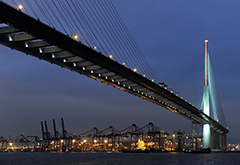Stonecutters Bridge is a high level cable-stayed bridge spanning the Rambler Channel in Hong Kong, connecting Nam Wan Kok, Tsing Yi to Stonecutters Island. The bridge deck was completed on 7 April 2009, and opened to traffic on 20 December that year. The bridge was the second-longest cable-stayed span in the world at the time of its completion. The approaches at Tsing Yi and Stonecutters Island are located near Container Terminal 9 and Container Terminal 8, respectively.
 The bridge is part of Hong Kong's Route 8, connecting Sha Tin, Cheung Sha Wan, Tsing Yi island, Ma Wan and Lantau Island. Other major constructions along the route are Nam Wan Tunnel (completed in 2008), Eagle's Nest Tunnel (completed in 2008), Sha Tin Heights Tunnel (completed in 2008), Tsing Ma Bridge (completed in 1997) and Kap Shui Mun Bridge (completed in 1997).
The bridge is part of Hong Kong's Route 8, connecting Sha Tin, Cheung Sha Wan, Tsing Yi island, Ma Wan and Lantau Island. Other major constructions along the route are Nam Wan Tunnel (completed in 2008), Eagle's Nest Tunnel (completed in 2008), Sha Tin Heights Tunnel (completed in 2008), Tsing Ma Bridge (completed in 1997) and Kap Shui Mun Bridge (completed in 1997).
 The bridge is part of Hong Kong's Route 8, connecting Sha Tin, Cheung Sha Wan, Tsing Yi island, Ma Wan and Lantau Island. Other major constructions along the route are Nam Wan Tunnel (completed in 2008), Eagle's Nest Tunnel (completed in 2008), Sha Tin Heights Tunnel (completed in 2008), Tsing Ma Bridge (completed in 1997) and Kap Shui Mun Bridge (completed in 1997).
The bridge is part of Hong Kong's Route 8, connecting Sha Tin, Cheung Sha Wan, Tsing Yi island, Ma Wan and Lantau Island. Other major constructions along the route are Nam Wan Tunnel (completed in 2008), Eagle's Nest Tunnel (completed in 2008), Sha Tin Heights Tunnel (completed in 2008), Tsing Ma Bridge (completed in 1997) and Kap Shui Mun Bridge (completed in 1997).The design concept for the bridge was procured by Highways Department in Hong Kong through an international design competition. The winning scheme was the one presented by a group consisting of bridge architect Dissing+Weitling together with engineering firms Halcrow Group, Flint & Neill and Shanghai Municipal Engineering Design Institute. The design was selected as the Reference Scheme for the further design development. A group led by Arup with COWI A/S as main sub-consultant has carried out the further design development of the Reference Scheme and the detailed design that followed.
The concept was for a cable-stayed bridge with a twin aerodynamic deck suspended from two 295m-high single pole towers. These towers have bases measuring 24m x 18m tapering to 7m diameter at the top, and the deck allows a navigation clearance of 73.5m over the full entrance to the Container Port.
The two towers are in concrete until level +175m and in composite construction consisting of an inner concrete ring with a stainless steel skin for the top 120m. The original concept had a conventional steel structure above level +175m but Arup found that this configuration would be too lively and lead to unacceptable vibrations of the stay cables. Using a heavier composite section instead of a pure steel structure solved this problem. For reasons of durability and to enhance the appearance, further studies concluded that the tower skin should be fabricated from a duplex stainless steel (grade 1.4462 to BSEN10088) with a shot peened surface finish. The deck itself is made of steel in the main span and of concrete in the side spans.
The tower foundations are located within 10m of the seawall on either side of the Rambler Channel, close to the back-up land next to CT8 and CT9. Their proximity to the channel necessitated ship impact testing and modelling. Geotechnical centrifuge testing was conducted using a 1:200 scale model of a vessel bow section and seawall within a container. More details

No comments:
Post a Comment